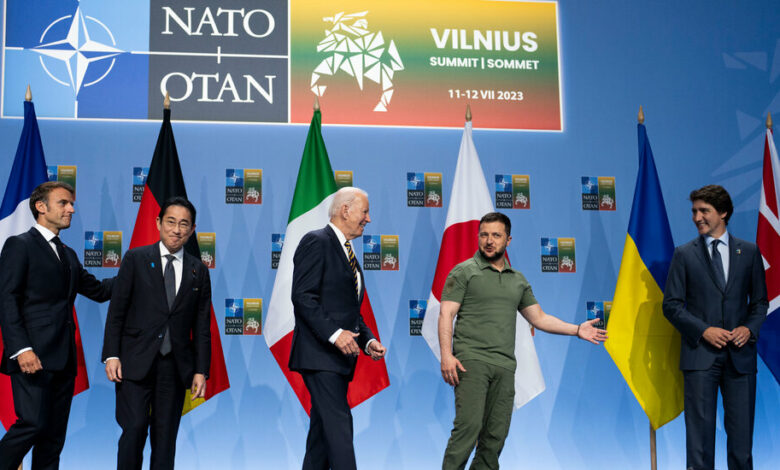As NATO meets, leaders worry about a hole in the middle

As President Biden and his advisers planned NATO’s 75th anniversary, which kicks off Tuesday night in Washington, they wanted to create an atmosphere of trust.
The message to Russian President Vladimir Putin and other potential adversaries would be that more than two years of war in Ukraine had created a larger, more powerful group of Western allies, more determined than ever to push back on aggression.
But with 38 world leaders arriving here on Monday, that confidence appears to be in jeopardy. Even before the summit formally begins, it is clouded by the uncertainty over whether Mr. Biden will remain in the race for a second term, and the looming possibility of the return of former President Donald J. Trump.
Trump has once called NATO “obsolete,” threatened to leave the alliance and recently said he would let the Russians “do whatever they want” to any country he saw as not contributing enough to the alliance. In recent days, as Trump’s post-debate poll numbers have surged, key European allies have begun talking about what a second Trump term might mean for the alliance — and whether it could take on Russia without American weapons, money and intelligence gathering at its core.
Mr. Biden will greet the leaders in the sprawling Andrew W. Mellon Auditorium, a few blocks from the White House, on Tuesday night — the same room where the treaty establishing NATO was signed in 1949, in a ceremony presided over by President Harry S. Truman. Mr. Biden was 6 years old then, and the Cold War was still in its infancy.
Now 81, he is perhaps the most outspoken advocate in Washington for an alliance that has grown from 12 members in 1949 to 32 as the era of superpower conflict returns. But when they convene on Tuesday night, leaders will be watching Mr. Biden’s every move, listening to his every word for the same signals Americans are focused on — whether he can go the distance of another four years in office.
Biden knows that, and said Friday in an interview with George Stephanopoulos on ABC that he welcomed the scrutiny. “Who’s going to hold NATO together like I have?” the president asked rhetorically. “I think a good way to judge me,” he said, is to watch him at the summit — and see how the allies react. “Come and listen. See what they say.”
Upon arrival, NATO leaders acknowledged that the alliance was facing an unanticipated test: whether it could credibly maintain the momentum it had built in supporting Ukraine, when trust in its key player has never been more fragile.
And they know that Mr. Putin and Xi Jinping, the leader of China, are also watching.
“NATO has never been a given, is not, and will never be a given,” Jens Stoltenberg, the alliance’s outgoing secretary general, said in a wide-ranging interview with reporters on Sunday. “We have done that successfully for 75 years. I am confident that we can do that in the future. But it is about political leadership, it is about political commitment.”
Months before the meeting, the alliance began hedging its bets in the event of a second Trump presidency. It is setting up a new NATO command to ensure a long-term supply of weapons and military aid to Ukraine even if the United States, under Trump, withdraws.
However, conversations with NATO leaders reveal that their plans to modernize their armed forces and prepare for an era that could be marked by decades of confrontation with Russia do not come with a commensurate increase in their military budgets.
More than 20 NATO members have now met the goal of spending 2 percent of their gross domestic product on defense, fulfilling pledges some made in response to Trump’s demands and others in response to the reality of the Russian invasion. That percentage — a goal set more than a decade ago, in an era when terrorism seemed the greater threat — seems far too small for the task ahead, many of Biden’s aides say.
In Europe, Germany has outlined plans to upgrade its military capabilities to deter Russian aggression, a transformation that Chancellor Olaf Scholz promised in the weeks after the Russian invasion. But Mr. Scholz’s grandiose plans have yet to be matched by a budget to pay for them, and the politics of public buy-in have proven so fraught that German officials refuse to put a price tag on them.
Carl Bildt, co-chair of the European Council on Foreign Relations and former Prime Minister of Sweden, wrote recently that European countries will need to “double their budgets again” “to credibly deter the threat from an increasingly desperate Russian regime.”
Still, White House officials said Monday that Biden would not push for new military spending targets.
But the most pressing problem for Mr Biden and Mr Scholz is avoiding another public confrontation with President Volodymyr Zelensky of Ukraine over how to portray his country’s eventual accession to NATO.
Last year, while traveling to Vilnius, Lithuania, for NATO’s annual meeting, Mr. Zelensky expressed dismay at the lack of a timetable for Ukraine’s accession to the alliance. “It is unprecedented and absurd that there is no timetable set, neither for the invitation nor for Ukrainian membership,” he wrote on social media at the time.
Upon his arrival, he was temporarily reassured by the alliance’s commitment that Ukraine could avoid a number of hurdles that other countries had to overcome before joining.
But NATO countries have been negotiating for months on language that would allow the issue to be circumvented, without allowing Ukraine to enter the country while the war continues.
In recent weeks, negotiators have agreed on a new approach: the alliance is expected to declare Ukraine’s eventual accession to NATO as “irreversible,” diplomats involved in the talks said.
While “irreversible” sounds definitive, it does nothing to address Mr Zelensky’s central demand: a date by which his country would come under NATO protection.
The case of Mr. Zelensky is of course the most urgent. But it is certainly not the only one.
Seventy-five years after NATO was founded to deter the Soviet Union threat at the start of the Cold War, some current and possibly future leaders among the alliance’s 32 member states appear sympathetic to Russia’s diplomatic entreaties, despite Moscow’s invasion of Ukraine.
Hungarian Prime Minister Viktor Orban visited Russia the other day, and in public remarks alongside Mr. Putin, he said nothing critical of the invasion, or the ongoing attacks on civilians. He hinted at seeking an opening for peace negotiations on terms similar to Russia’s demands.
The White House criticized the visit on Monday. John F. Kirby, a spokesman for the National Security Council, said Orban’s visit “certainly does not appear to be productive in terms of trying to get things done in Ukraine,” adding: “It is concerning.”
But to avoid an open split within NATO on the eve of the summit, Stoltenberg held back from criticizing Orban, noting that “NATO allies deal with Moscow in different ways and at different levels.”
Still, he suggested that trying to reach a settlement while Putin advances in Ukraine would not ultimately bring peace. “We all want peace,” Stoltenberg said. “It is always possible to end a war by losing a war. But that will not bring peace — that will bring occupation, and occupation is not peace.”




